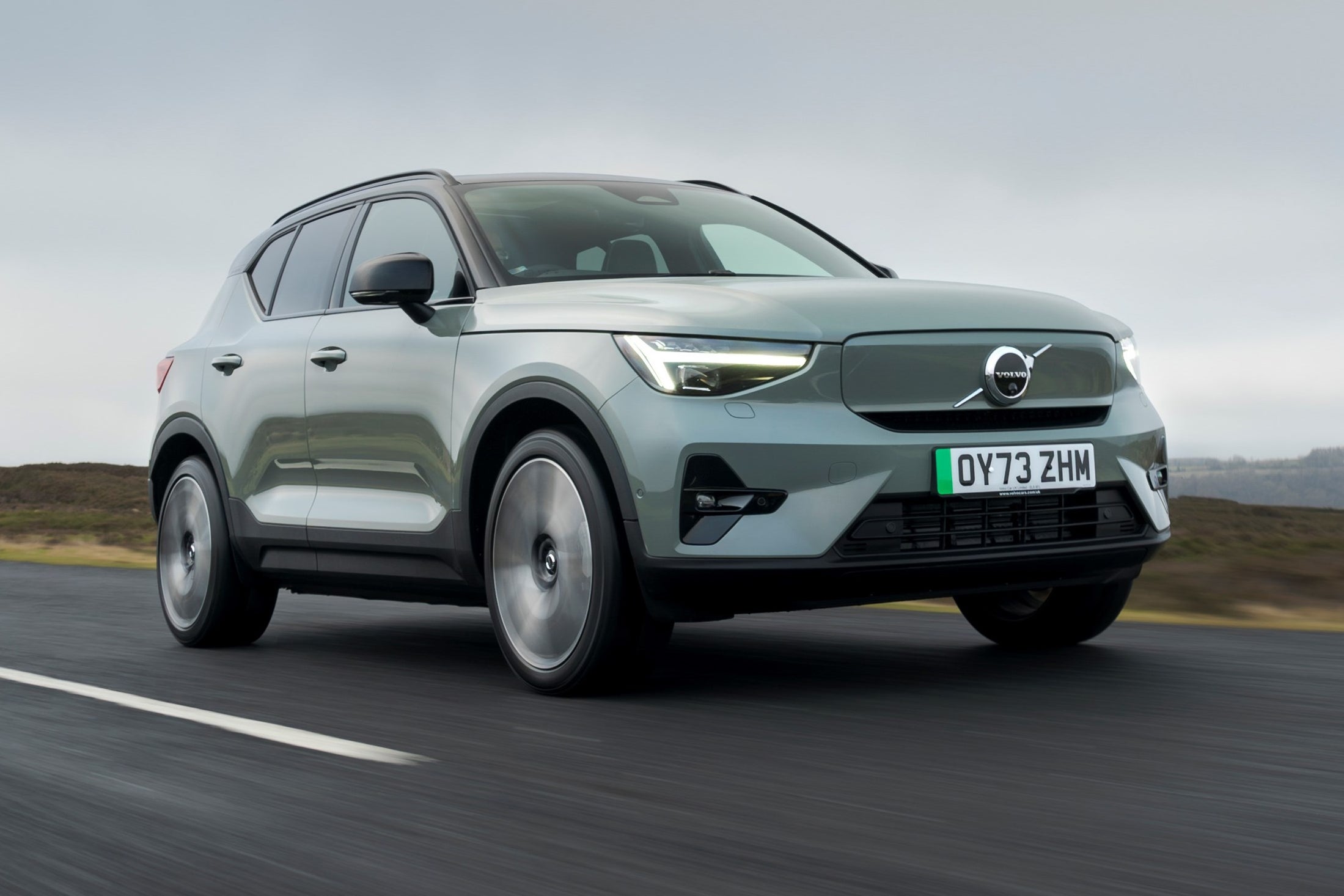Volvo EX40 Review 2025: Price, specs & boot space
Written by Ivan Aistrop
Quick overview
Pros
- Very stylish inside and out
- Comfortable and refined to drive
- Lots of standard equipment
Cons
- Some rivals are more practical
- Many are also more enjoyable to drive
- Doesn’t come cheap
Overall verdict on the Volvo EX40
"Volvo is a car company that has serious form for bamboozling folk with the way it names its various products, but with the EX40, the Swedish firm has truly surpassed itself. Allow us to explain, although do excuse us if it takes a bit of time."
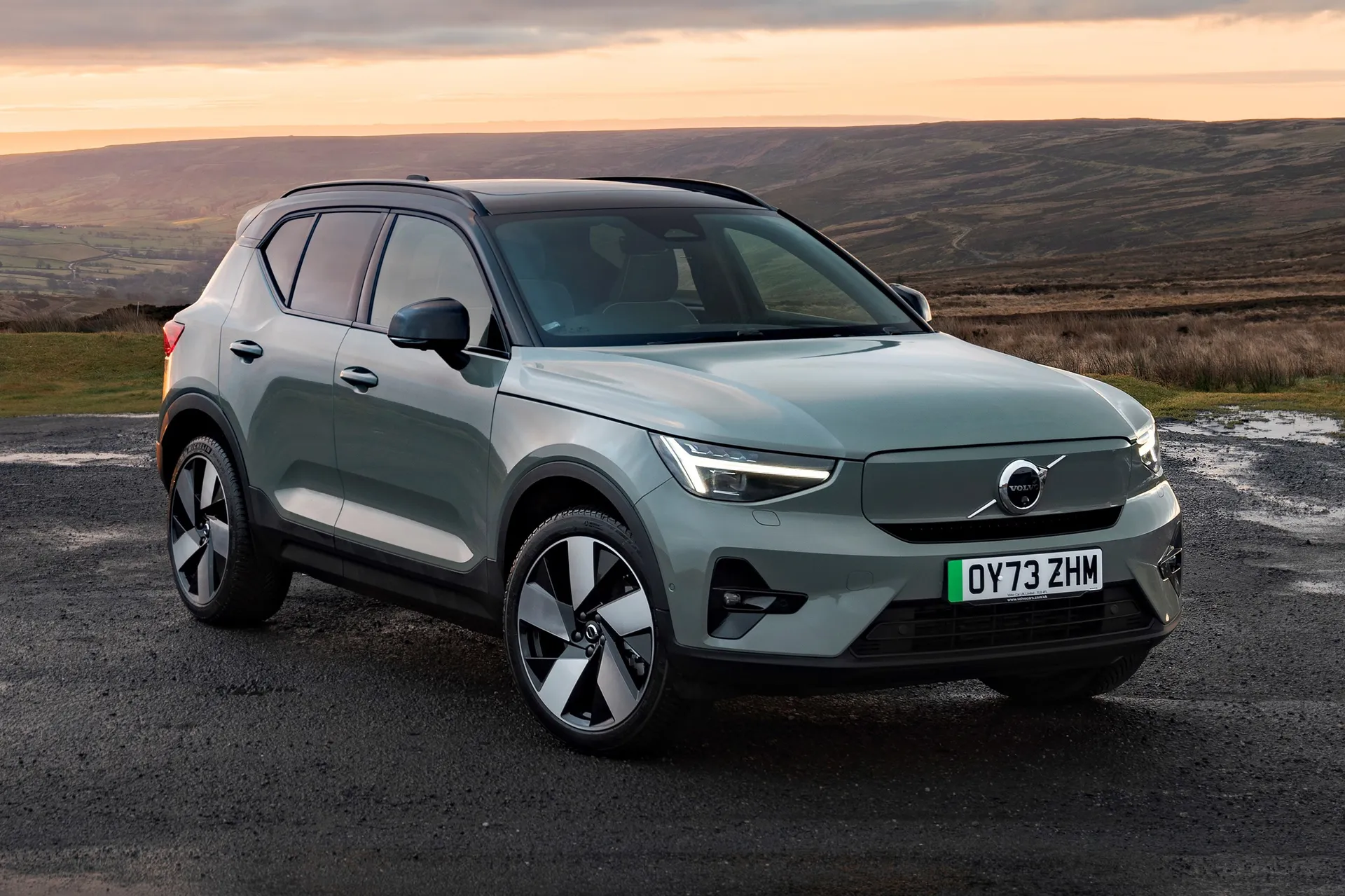
You’re probably already familiar with the XC40, the company’s compact crossover SUV that’s been doing the rounds since 2018. That car has, over time, been offered with petrol, diesel, mild hybrid and plug-in hybrid powertrains, and a few years ago, an all-electric version was also introduced. This has been known by a variety of names over time, including among others, the XC40 Recharge.
However, Volvo has recently released a couple of other electric SUVs in the form of the smaller EX30 and the larger EX90, and that’s resulted in a new naming convention for such vehicles into which the XC40 doesn’t fit. The same goes for the C40, an electric-only coupe-roofed version of the same car.
So, to keep things simple and consistent - great job there, lads! - Volvo has renamed the XC40 Recharge and C40 as the EX40 and EC40, respectively, in order to fit with the new way of things. The XC40 name carries on, though, because that still refers to the combustion-engined versions of the car. Confused? Well, don’t blame us…
Whatever you call it, the appeal of the car is still largely the same as before. It takes Volvo’s now-trademark chic Scandi design and applies it to a small and relatively affordable electric family SUV. Quality is high, and technology and equipment levels are too, and although it’s not a cheap car, it does promise low running costs for those whose life suits electric motoring.
Performance levels for the various powertrain choices range between adequate and awe-inspiring, and talking of range, even the worst version gets close to an official figure of 300 miles on a full charge. It’s not the most exciting car of its type to drive, perhaps, but it’s comfortable and refined on the road, and for many, that’ll be enough. It’s a similar story on practicality: the Volvo EX40 is by no means class-leading on that score, but it’ll be adequate for most of those potential customers taken with its cool styling and desirable image.
Looking for a used car for sale? We've got 100s of Volvo Approved Used Cars for Sale for you to choose from, including a wide range of Volvo EX40 cars for sale.
Is the Volvo EX40 right for you?
If you want an all-electric SUV that can match premium-badged rivals for class and poshness, but that has a bit more style and swagger, then the Volvo EX40 makes an excellent choice. It’s a comfortable and refined car to drive, while it’s practical enough for family life and it comes fabulously well equipped. If that sounds good to you, then the Swedish firm’s small electric SUV will suit you down to the ground.
What's the best Volvo EX40 model/engine to choose?
That largely depends on how much range you need, as each version of the EX40 gives a slightly different return on that score. For those needing maximum range for long schleps, we’d recommend the Single Motor Extended Range car as that one will go the furthest between charges and only costs a couple grand more than the entry-level car. That said, if you only do exclusively short journey’s then you might as well save yourself that couple of grand. We can’t imagine anyone needing the ballistic performance of the Twin Motor models, but we can imagine plenty of people wanting it.
What other cars are similar to the Volvo EX40?
As a small, premium-badged all-electric SUV, the Volvo EX40 has no shortage of competitors. Predictably, most come from Germany: BMW offers the iX1 and iX2, Audi Offers the Q4 e-tron, while Mercedes-Benz offers an alternative in the form of the EQA. There are some more left-field alternatives, too, such as the Alfa Romeo Junior and Lexus UX300e.
Comfort and design: Volvo EX40 interior
"Chic interior design has been one of the things that has marked Volvo out relative to its more conservative premium competitors in recent years, and that’s something that remains true with the EX40."
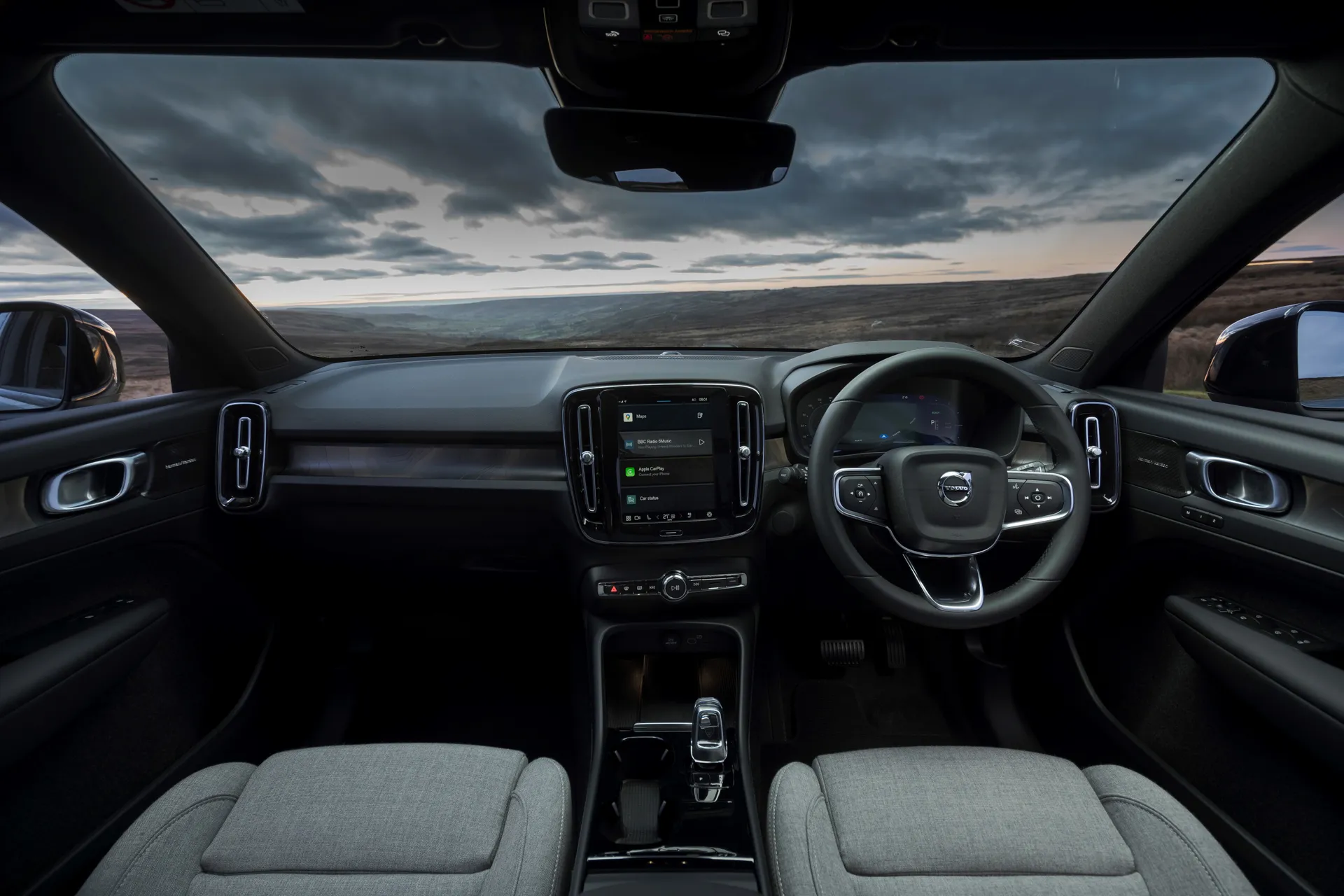
There’s a stylish and sophisticated feel to the car’s cabin that you just don’t get in rivals, and that’s helped by the impressive quality and plush materials on display: more on that a bit later.
For several years, seats have been a Volvo speciality, and those in the EX40 continue that tradition. The front pews provide excellent support in all the right places for exceptional comfort, while there’s lots of adjustment for the driving position. The driver’s seat moves electrically in all but the base-level trim, too, making it even easier to dial in your preferred position.
Quality and finish
This is an area in which the EX40 impresses. Its cool Scandi design is complemented by imaginative and tasteful use of a mix of materials - the precise makeup of which is governed by the car’s trim grade - featuring high-grade plastics, authentic-looking woods, various metallic elements, convincing synthetic leathers, recycled fabrics and thick carpets.
The way everything is assembled also feels very solid, adding to the car’s substantial feel. All in all, it feels like a match for most of its premium-brand competitors in terms of poshness.
Infotainment: Touchscreen, USB, nav and stereo in the Volvo EX40
All versions of the EX40 get the same 9.0-inch infotainment touchscreen in the centre of the dashboard, which has all the functionality you’d want including Apple CarPlay and Android Auto. The operating system was developed in conjunction with Google, so the navigation uses the latest Google Maps, there’s Google’s voice assistance built-in, and you can download a variety of apps through the native Google Store.
The system impresses in other ways, too, with fast responses and logically arranged menus. That said, there is a similar over-reliance on touchscreen tech to that you’ll find in many other modern cars, and it’d be nice if there were a few more physical buttons and switches with which to perform key functions, as these would be easier and less distracting than the touchscreen.
Space and practicality: Volvo EX40 boot space
Space in the front of the EX40 is as generous as you’d expect, but space in the rear seats is decidedly tighter, which is far from uncommon. The amounts of headroom and legroom you get are reasonable by class standards, but some rivals give you a little more room to stretch out, and the cabin is a little narrow by comparison as well. This means that, while there are three rear seat belts, three adults will not want to be crammed in back there for too long. Whoever ends up sitting in the middle seat will have an even more miserable time, because it’s narrow and flat, and there’s limited foot space. The EX40 is much more comfy when used as a four-seater.
At 410 litres, the EX40’s boot is by no means the biggest in the small SUV class, but the space is a good shape and there’s no load lip to get in your way when loading heavier items. Your charging cables won’t have to take up much-needed boot space, either, because there’s a 31-litre loadspace under the bonnet where they can live.
Handling and ride quality: What is the Volvo EX40 like to drive?
"As you’ll find out in the section after this one, the versions of the EX40 that we’ve driven are sensationally fast. That aside, however, it doesn’t feel like a remotely sporty car to drive."
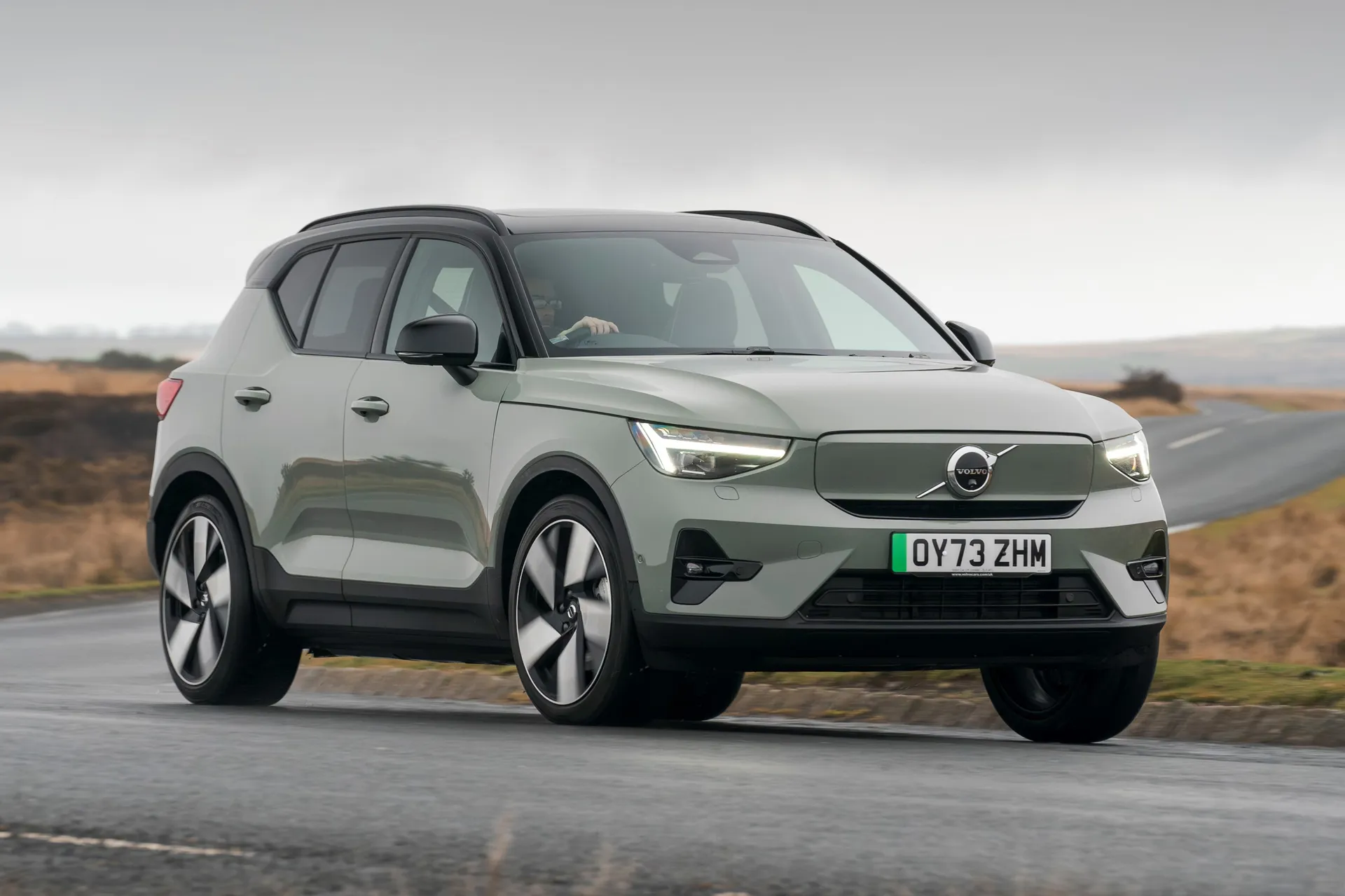
Comfort is prioritised over handling ability, just like it is in most Volvos, and that means the suspension has a rather soft and squishy feel. This makes it very good at absorbing bumps and potholes at most speeds, keeping life comfortable and easy-going for most of the time. This easy-going nature is complemented by the inherent refinement of the all-electric powertrain.
However, put the car on an undulating road, and you can feel the body bobbing up and down a bit, making the car feel a bit floaty and uncontrolled. It’s nothing that’ll make the kids poorly, but it still doesn’t feel as tidy and as tied down as many rivals. It’s a similar story in corners, where body roll is more pronounced than in many rivals, and the feeling of agility is impaired further by steering that is very light and lacking any meaningful feedback. There is plenty of grip and traction, mind, probably thanks in part to our test car’s dual-motor four-wheel drive.
What motors and batteries are available in the Volvo EX40?
Although the EX40 is only available with an all-electric powertrain, you still have a variety of different powertrains to choose from. First up is the entry-level Single Motor car, which as the name suggests, has a single electric motor powering the rear wheels, delivering an output of 238PS. This gives a 0-62mph acceleration time of 7.3 seconds.
The Extended Range version has the same basic arrangement, but with a slightly bigger battery for slightly more range. It has a shade more power at 252PS, but the added weight of the extra battery cells means that the acceleration figure is still 7.3 seconds.
Then comes the Twin Motor version, which adds a second electric motor to the front axle. This gives all-wheel drive and hikes power up to 408PS. Predictably, the 0-62mph sprint time plummets, with the benchmark completed in 4.8 seconds. Then there’s the Twin Motor Performance variant, which uses the same basic layout, but hikes power further to 442PS. The 0-62mph sprint is cut further to 4.6 seconds. Like with all Volvos, the top speed of all versions is limited to 112mph.
The only one we’ve tried so far is the non-Performance Twin Motor with 408PS, and as you’d expect, it certainly isn’t short of go. All of the motors’ power and torque is available the very instant you push the accelerator pedal, and there are no gearchanges to interfere with the unfurling of the ferocity. If anything, the rate of acceleration feels even more aggressive than the numbers suggest.
Maximum electric range in the Volvo EX40
The official WLTP range of your EX40 will depend on which version you get. The entry-level Single Motor version has a battery pack of 69kWh (nominal capacity, equating to 66kWh usable) and that gives it an official range of up to 296 miles. The Single Motor Long Range version, unsurprisingly, has a larger battery pack of 78kWh (75kWh usable) to give it a range of up to 343 miles, the longest of any EX40.
The Twin Motor version’s battery is bigger still at 82kWh (79kWh usable), but the extra power sees the maximum official range drop to 332 miles, while in the Twin Motor Performance, that same battery delivers a maximum of 326 miles.
As always, though, these figures should not be relied on day-to-day, because there are several variables that affect how quickly you get through your level of charge. Long motorway journeys will see charge levels drop a lot more rapidly than usual, as will cold weather. Even as a best-case scenario, we wouldn’t bank on getting much more that 250 real-world miles out of any EX40 on average.
Refinement and noise levels
Like most electric cars, the Volvo EX40 is quieter than any combustion-engined alternative, because while petrol and diesel engines always give off some sort of mechanical clatter when running, electric motors give off little more than a faint whirr, no matter how much power they’re transmitting to the drive wheels at the time.
That in itself makes the EX40 a very peaceful way to get around, and the effective suppression of wind- and road noise helps on that score as well, although you will hear a bit more of the latter in versions fitted with bigger wheels. What you might not expect, though, is the amount of suspension noise you hear. Like we said, the soft suspension is good at mopping up lumps and bumps in the Tarmac, but it clonks a fair bit as it goes about its work, so those lumps and bumps actually end up sounding a lot worse than they feel.
Safety equipment: How safe is the Volvo EX40?
Few - if any - car manufacturers have carved out a reputation for safety quite like Volvo’s, and for very good reason: it’s an area that the Swedish firm has invested and innovated in greatly over the years.
Predictably, the EX40 comes with much of the latest safety tech, but precisely how safe your car will be will depend on the version you get. Entry-level Core models have autonomous emergency braking, lane departure warning and lane keep assist, but Plus and Ultra specs add even more preventative safety measures, including blind spot monitoring, rear cross traffic alert with rear collision warning, and adaptive cruise control with semi-autonomous driving functionality. The car was crash-tested by Euro NCAP way back in 2018 when it was known as the XC40, and it achieved the full five-star rating. That’s not particularly surprising when every Volvo tested since 2001 has achieved the same feat.
Volvo EX40 charging times: How much does it cost to charge?
"Plug your car into a regular three-pin domestic socket, and it’ll take between 22 hours and 25 hours for your EX40 to take on a full charge. That’s one of the reasons we don’t recommend doing so on a regular basis, the other being that it’s not awfully good for your home’s electrics."
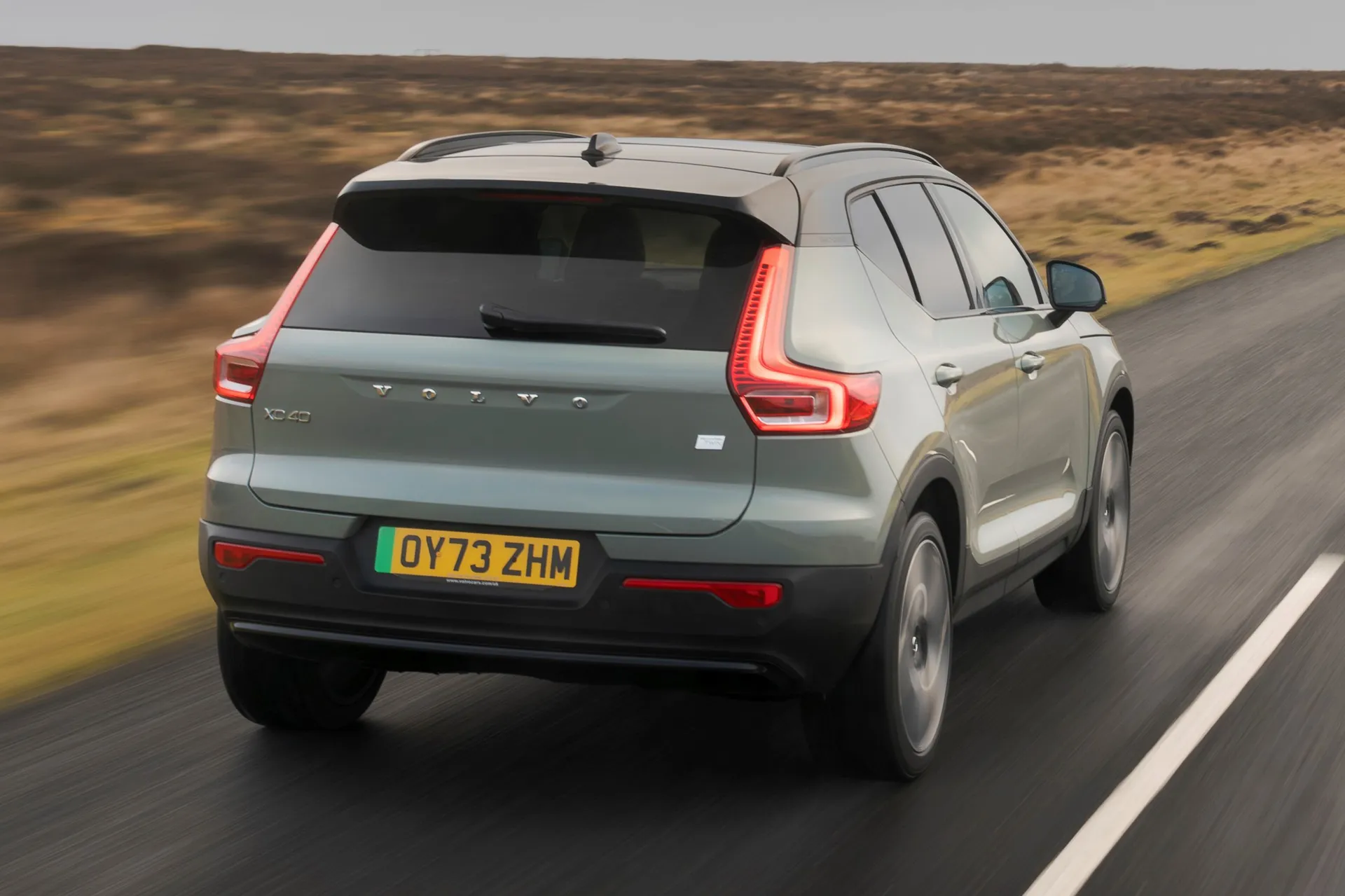
Do what most folk will, and have a 7kW home wallbox charger installed, and charging times will be greatly improved. The smaller battery of the Single Motor version will take on the same charge in 11 hours, while the bigger battery of the Extended Range car increases that to 12 hours, and you’re looking at more like 13 hours for the two Twin Motor cars.
Different versions of the EX40 have different maximum figures for DC rapid charging. The Single Motor version has a maximum figure of 135kW, while the Extended Range ups that to 155kW, and the Twin Motor versions can charge at up to 205kW. Due to the varying sizes of the batteries in each, though, a 10-80% top-up will take around half an hour in each case at an appropriately powerful public rapid charger.
If your domestic electricity is priced at the UK’s national average, then you can expect a full charge of the Single Motor to cost around £18, while you’ll pay £21 to fill up the Extended Range car with electricity and £22 to juice up the Twin Motor cars. If you can get yourself on a home power tariff that allows you to charge your car overnight at a discounted off-peak rate, then you’ll likely pay less than half that for a charge. However, regular use of public rapid chargers will hit you in the pocket severely, as the power delivered by these usually costs at least twice the average domestic amount, and often more.
Volvo EX40 reliability and warranty
Take a look at the latest HonestJohn.co.uk Satisfaction Index, and the EX40 (and XC40 equivalents are conspicuous by their absence. The cars don’t feature in our list of the best performers, both in the areas of reliability and overall satisfaction, but neither do they feature in our lists of the worst performers. Look at the performance of Volvo in the brand standings for overall customer satisfaction (in which reliability plays a part), and you’ll see that the Swedish firm sits 14th out of the 29 car makers considered. And you can’t get much more middle-of-the-road than that.
Volvo’s warranty is also quite middle-of-the-road, unfortunately, with a bog-standard three years, 60,000 miles of cover provided. The battery, meanwhile, is covered for eight years, 100,000 miles, which again, is pretty bog-standard.
Volvo EX40 insurance groups and costs
Insurance groupings work on a scale of 1 to 50: cars that fall into group 1 are the cheapest to insure, while cars that fall into group 50 will have the most expensive premiums.
The most basic version of the EX40 sits in group 33 for insurance, while most of the Extended Range versions sit just above in groups 34 and 35. The most powerful Twin Motor versions, meanwhile, sit in group 40. No version of the EX40 will be cheap to insure, then, but premiums won’t be outlandish compared to those of rivals, either.
VED car tax: What is the annual road tax on a Volvo EX40?
As a fully electric car, you pay nothing in the way of annual VED road tax right now. Be careful, however, because that’s not going to remain the case for long. As of April 2025, VED exemption for EVs is set to be scrapped, and you’ll likely pay the same - or a similar - amount as you will to tax a combustion-engined car.
Volvo EX40 price
"If buying brand new, prices start at around £46,000 for the entry-level Single Motor Core model, with the Extended Range version costing more like £48,000. However, prices ramp up quickly as you move further through the choices of trim levels and powertrains, with the most expensive versions costing upwards of £60,000."
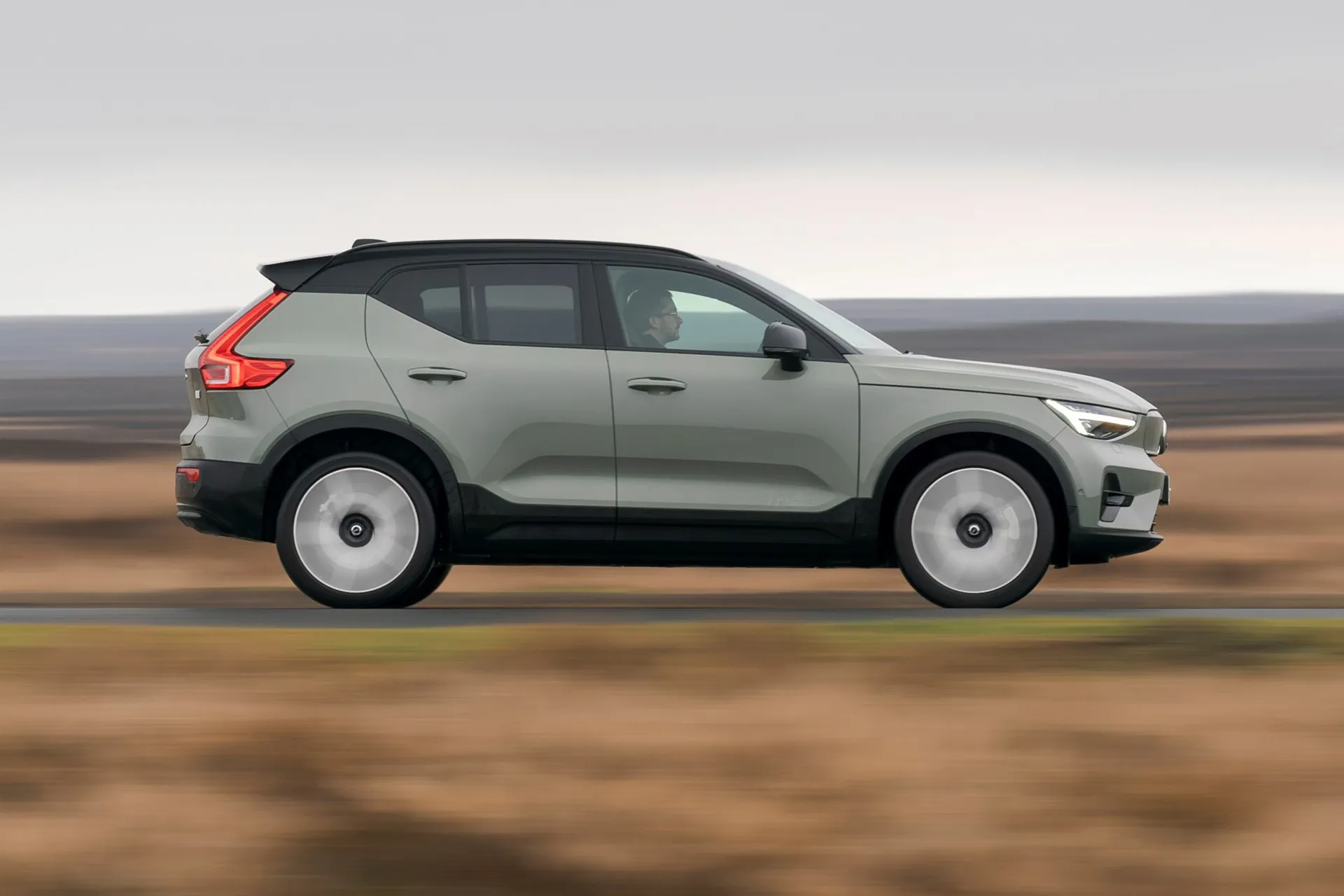
Even though the EX40 hasn’t been around for all that long under its latest name (it’s been around for yonks under its various other names, mind), you will still find quite a few used examples if you have a browse of the heycar listings. Savings are still modest at this early stage, but compared with prices of the equivalent brand new version, you stand to save around £2,000 or £3,000. That’s not to be sniffed at, and savings will become bigger as time goes on.
Trim levels and standard equipment
The Volvo EX40 is offered in three trim levels. The entry-level version is called Core, but it’s still very generously equipped, with 19-inch alloy wheels, LED headlights, power folding door mirrors, rain-sensing wipers, two-zone climate control, cruise control, heated front seats, rear parking sensors, a reversing camera, a powered tailgate, and wireless phone charging.
The mid-range trim is called Plus, and this adds quite a lot of desirable equipment. This includes a contrasting roof, rear privacy glass, keyless entry, front parking sensors, a hands-free powered tailgate, a powered driver’s seat, a heated steering wheel, heated rear seats, and adaptive cruise control with added semi-autonomous driving functionality. You also get a heat pump, which gives more efficient heating of the cabin to preserve your car’s range in winter.
The range-topping Ultra trim gets even more, with 20-inch wheels, self-cleaning headlights, a panoramic sunroof, 360-degree cameras, a powered passenger seat, power folding head restraints, and a Harman Kardon premium sound system.
Black Edition models are also available, but these simply have black paint, black wheels and black exterior badging, along with some different interior trim. Otherwise, equipment levels are the same as on the rest of the range.
Ask the heycar experts: common questions
Is the Volvo EX40 a good car?
What’s the difference between the Volvo EX40 and the Volvo XC40?
What’s the range of the Volvo EX40?
Get our latest advice, news and offers
Keep me updated by email with the latest advice, news and offers from heycar.
By submitting you agree to our privacy policy
